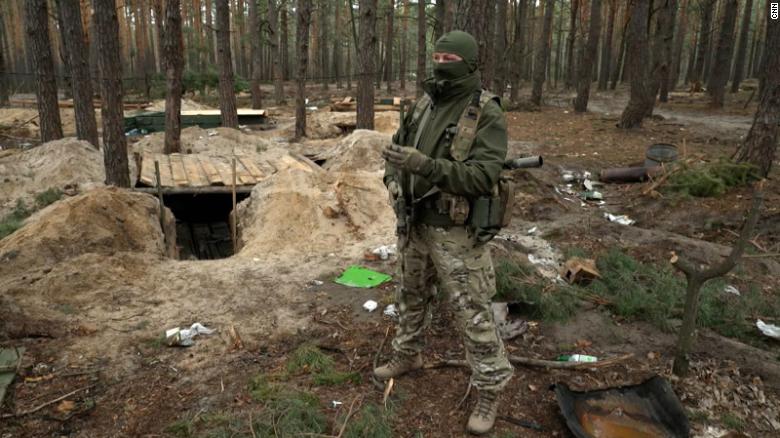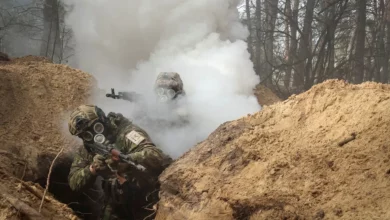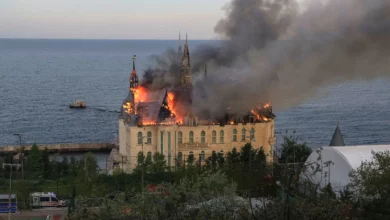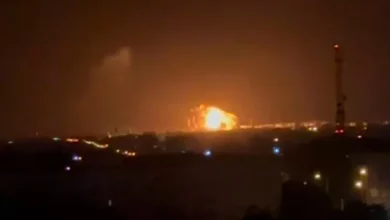
Hostomel, Ukraine (CNN) – Dmitry Nekazakov was walking his dog before he went to work when the Russian shelling started on Hostomel, a city on the outskirts of the capital, Kyiv. The sky buzzed with low-flying helicopters from which Russian troops jumped, while rockets rained down.
It was 6:40 am on February 24, the first day of Russia’s invasion of Ukraine, and for almost a month, the bombardment there didn’t stop. Nekazakov said he spent 20 days sitting on the ground in his basement during the night. In the cold light of day, he and other residents in his neighborhood would emerge to witness the damage that had been inflicted on their homes, and devise plans to find safer places to shelter.
“For a long time, the shells were coming — the rockets were coming,” he said.
The Russian missiles and rockets that decimated buildings, lives and homes were fired from a sprawling Russian base, hidden in the forest some 4 kilometers (around 2.5 miles) away.
Now, only the remains of that sprawling military camp sit among the trees. CNN was shown around the camp by Ukrainian special forces, who are picking up clues as to what Russia’s plans may have been for the capital among the debris.
Earlier in the invasion, as Russian troops surged toward Kyiv, Ukrainian special forces believe 6,000 marines set up camp in this pine forest for a month, through the rain, snow, and temperatures that dropped to -12 degrees Celsius (around 10 degrees Fahrenheit). The site included a main command post and headquarters. It was from here and a nearby field that the Russian army launched attacks on Kyiv, Hostomel and the nearby city of Bucha.
“Here they made a decision on the deployment of further actions, on the directions of the offensive, tactics of action, and so on,” a Ukrainian special forces officer told CNN, pointing to where each part of the operation was located.
Huge grooves are visible where troops had fired grad missiles from a field, located forty kilometers (around 25 miles) from the capital. In the woods, discs from grad missiles that had been launched and ammunition cases litter the floor at launch positions.
The Russian forces built dugouts, command posts, ammunition storage and communication lines using the trees and wood from the forest.
They slept in underground fortifications, covered with timber and green wooden boxes that had once contained BM-21 grad multiple rocket launchers and tube artillery. Black wires connected each of the shelters across the forest for communication.
The forest was also littered with food containers emblazoned with the branding of the Russian military: A special forces member uncovered a sodden notepad left behind, containing instructions from a previous mission in Azerbaijan. A Russian camouflage and concealment instruction manual was also discovered at the scene, along with clothing and shoes.
Gesturing to the size of the camp, one officer told CNN, “Russians fight not in quality, but in quantity.”
“They do not consider soldiers as people, for them they are cannon fodder and consumables. The tactics of the Russian army resemble, perhaps, the Middle Ages, when they took not by skill, but by quantity,” he added.
Remnants of military equipment, clothing, and fortifications are not the only things the Russians left behind.
Russian soldiers stormed into nearby neighborhoods, took over homes and terrorized residents who they came into contact with, according to local residents and a priest.
The torture, humiliation and shallow graves of people killed by those at the base now haunt those villages.
‘I was beaten…but I am alive’
Vitaliy Chernysh, from the village of Zdvyzhivka on Kyiv’s outskirts, said he was cycling through his village when he was captured by Russian forces, who were “hunting for Nazis.” He said they held him for nearly 24 hours.
Chernysh remembers praying in what he thought would be his last minutes alive. “[I was] blindfolded, hands tied and around me. They were shooting,” he told CNN.
Chernysh said he was locked up in a shed after he had been forced to walk through a minefield. He said that Russian soldiers were mulling whether to douse him with gasoline and had threatened to take him to the crematorium. The soldiers shot all around his body as he was tied up, and constantly asked him what his last wish would be, he said. He sad he was left in the freezing shed for hours.
“I was beaten on the arms and legs, below the waist. The bruises remain,” he said. I thought my leg was broken, I was limping. But I am alive and well, thank God.”
In his garden, a rocket artillery still lies in his field — another daily reminder of his painful ordeal and the near month under Russian occupation and attack. Chernysh survived, but other residents were killed after being tortured by soldiers who spilled out of their forest fortress.
Vasiliy Benca, a local priest in Zdvyzhivka, told CNN that Russian troops, tanks and armored cars converged on the village and remained there for a month. People were scared to emerge from their basements, he said. When Benca did, he said he found five men whose bodies had been mutilated in the garden — and two more in the forest.
“Russians asked — or forced — me to bury two (additional) women in the cemetery,” Benca told CNN.
Nekazakov, who fled when the Russians attacked his village, has now returned to his Hostomel home. He remembers all of the bodies he drove by when he left, he said, and regrets he couldn’t do anything about it.
Now, he said, he feels hatred for Russian President Vladimir Putin and the soldiers who ravaged his hometown.
“I feel only hate. We wouldn’t have thought in hundreds of years that this could happen,” he said, looking at the graves of those who died. “We cannot forgive it for the rest of our lives.”




